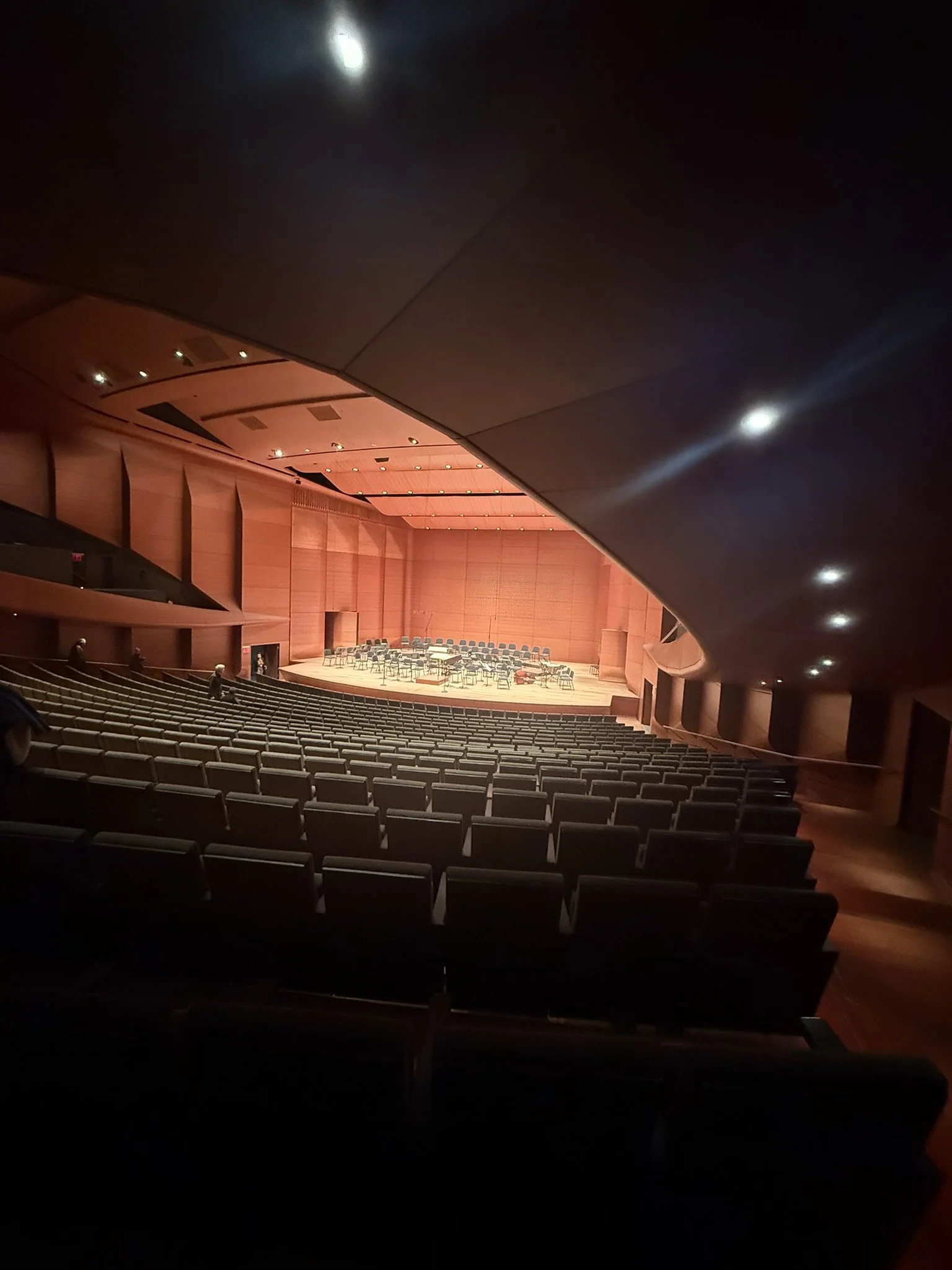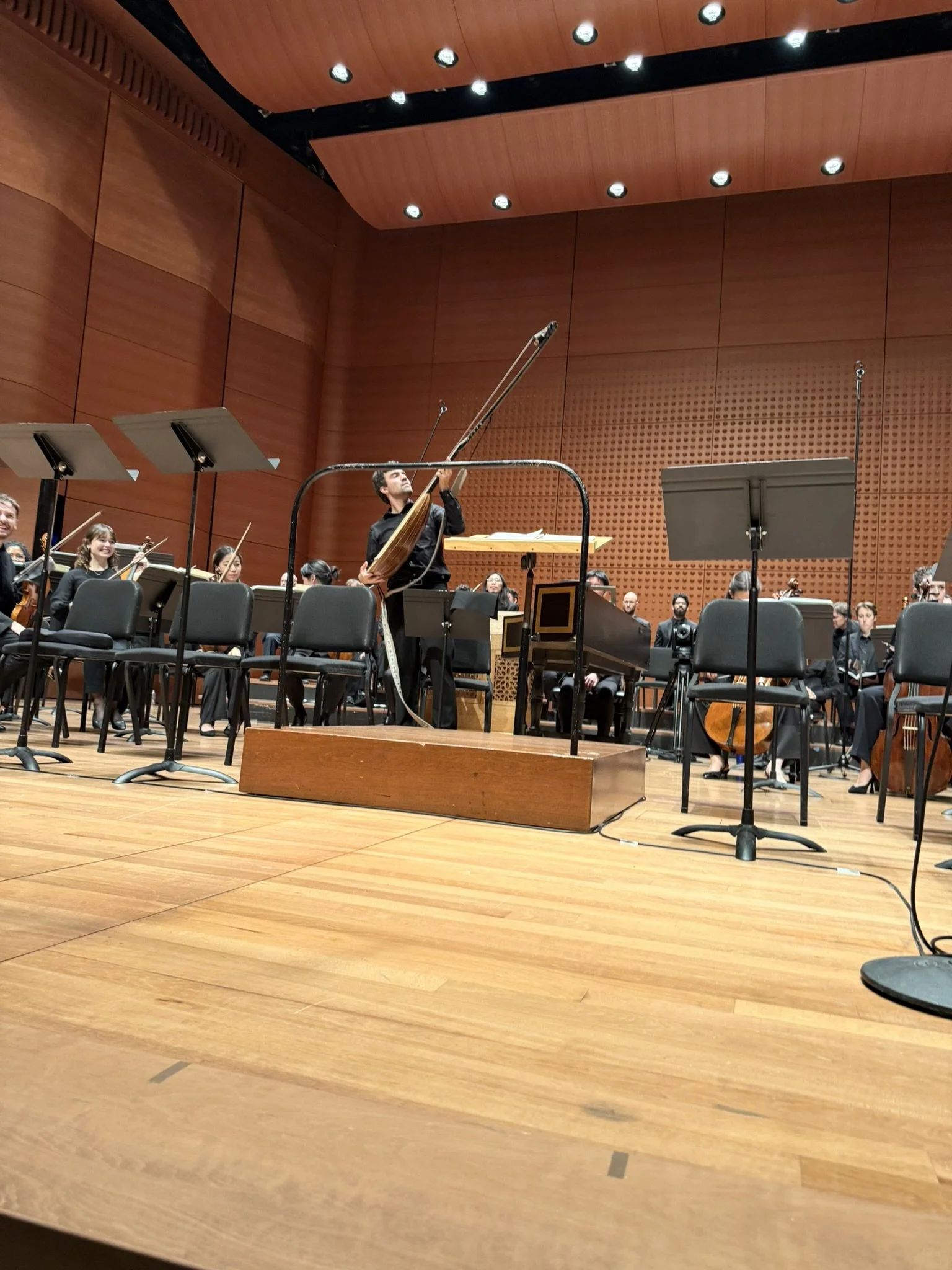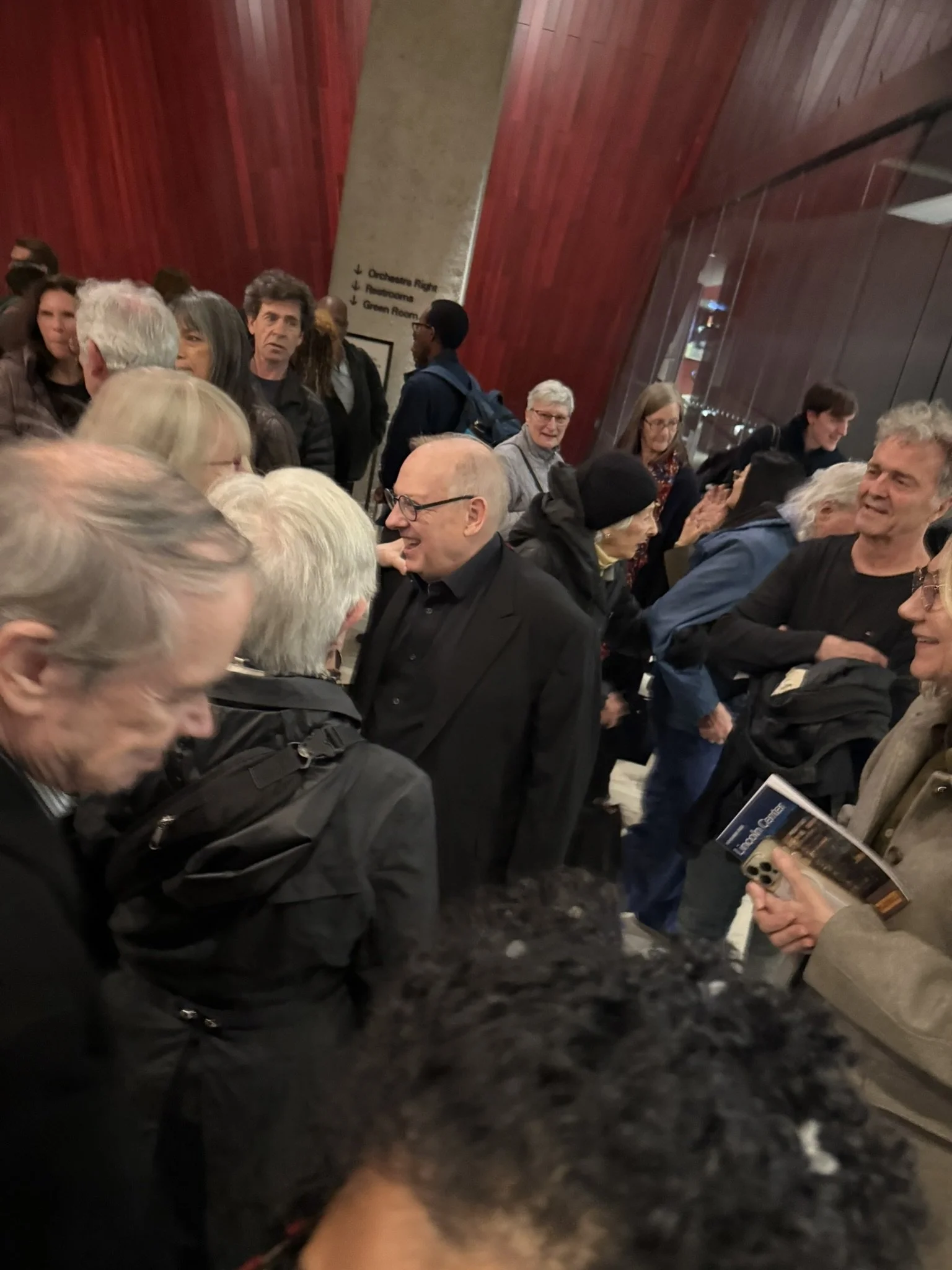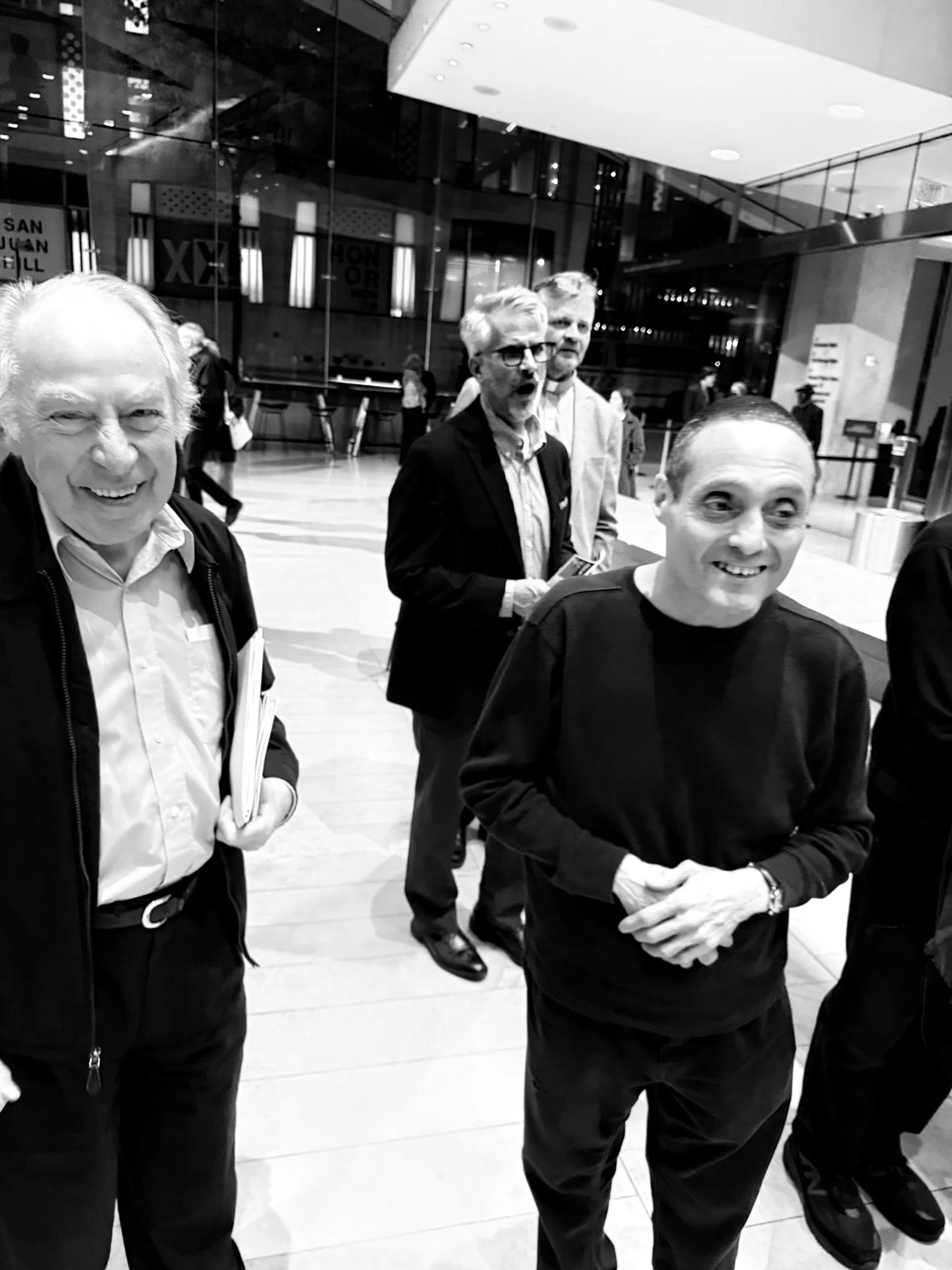Juilliard415 With Yale Schola Cantorum
Sunday, 11.8.2025
Nicholas McGegan, Conductor
HANDEL Jephtha librett
Handel’s oratorio Jephtha (1751) was performed by Juilliard415, Juilliard School’s period-instrument ensemble, on November 8, 2025, at Alice Tully Hall. This, his final oratorio, featured accompaniments to the arias that were varied and richly textured. The vocal ensemble consisted of five singers, ranging from soprano to bass, and the orchestra was full and vibrant. Even the basso continuo accompanying the recitatives was luxurious.
The story follows the Israelite general Jephtha, who, before going into battle against the Ammonites, vows, “If you grant me victory, I will dedicate to God the first person who comes out of my house to greet me.” When he returns victorious, the first to greet him is his beloved daughter, Iphis. Jephtha is devastated and struggles deeply between his vow and his love as a father. However, a divine angel appears and commands that, instead of being sacrificed, Iphis should dedicate her life to God and live a pure and holy life. Thus, the tragedy turns into a story of salvation and forgiveness through faith.
Jephtha depicts the human struggle and the path to redemption across its three acts. The first act begins with a solemn overture, followed by music expressing determination and faith in battle. The second act shifts from victory to tragedy, with arias and choruses portraying humanity’s conflict with fate. The third act is filled with silence and prayer; gradually, light emerges, bringing a sense of peace and forgiveness, and the oratorio concludes quietly with the chorus singing, “Whatever is, is right.”
This is a theme that Beethoven loved. The music portrays the structure of reaching truth through suffering and the inner struggles of humanity. Beethoven studied Handel intensively; he owned scores of Messiah, Jephtha, and Solomon, and is known to have analyzed their counterpoint and harmonic structures.
At the end of the first act, the aria “When His loud voice in thunder spoke,” in which Jephtha expresses his trust in victory and dedicates himself to God, shares the same harmonic progressions and melodic movement as the rondo in the third movement of Beethoven’s Piano Concerto No. 3. Both works depict human struggle and determination in the face of the divine—a sacred and moral drama in C minor.\
24. Chorus of Israelites
When His loud voice in thunder spoke,
With conscious fear the billows broke,
Observant of his dread command.
In vain they roll their foaming tide,
Confin’d by that great pow’r,
That gave them strength to roar.
They now contract their boist’rous pride,
And lash with idle rage the laughing strand.
The music depicts the power of nature (the waves) and the order of God. It features a horn obbligato, and in the latter part, a fugue unfolds with continuous sixteenth and eighth notes. Beginning with a female chorus, the melismatic lines evoke the movement of the waves, perhaps laughing or frolicking.
It represents the realization that, no matter how one is swept away by pride or anger, one is powerless before God or fate.
The voice of God and the power of nature are developed contrapuntally, reflecting the surging and receding of the waves. The melismas of the female chorus suggest the murmuring of the waves, gradually realizing their powerlessness before fate, blending awe and serenity. Here, Handel portrays the movement of nature through music, illustrating how the world falls silent before the word of God.
The Act III aria Waft her, angels is a serene and prayerful piece.
Waft her, angels, through the skies,
Gently waft her, where she lies;
Waft her, angels, to the place
Where she may behold his face.
This section sounded remarkably similar to the cello theme in the fourth movement of Brahms’s Symphony No. 3. It is unclear whether Brahms knew Waft her, angels, but the theme itself is common in Baroque music.
Listening to Handel with Juilliard415, I felt a sense of connection to the spirit and melodic sensibilities of Beethoven and Brahms—it seemed as if their musical ideas were rooted in these Baroque works. This suggests how deeply they studied these compositions.
At the end of Act I, the aria “When His loud voice in thunder spoke” portrays the waves and the power of nature in a way that evokes the strength and fugue-like structure reminiscent of Beethoven. In Act III, Waft her, angels presents a pure and prayerful melody that recalls the cello theme from the fourth movement of Brahms’s Symphony No. 3. I was struck by how Handel’s music continues to resonate across history, influencing later composers. Within a single oratorio, one can hear a condensed flow of music history.
Conductor Nicholas McGegan masterfully shaped the performance. In Act I, he gradually built the waves and the fugue to reach climaxes, contrasting the intensity of battle and tragedy with the serenity of Waft her, angels, clearly expressing the emotional trajectory. He skillfully balanced solos, female chorus, horns, and strings to highlight melodies and nuances, using dynamics, tempo, and ornamentation to create the overall pacing of the drama. As a result, the music naturally concentrated toward climaxes, and the tension and calm flowed seamlessly with the structure of the oratorio.
Ian Jones, as concertmaster, displayed remarkable talent in leading and accompanying the vocal lines with obbligato. Sharing breath with his fellow musicians in the same section while coordinating with other parts, he adapted his playing to the individual singer’s style, supporting the solo while adding his own ornaments to enrich harmony and color. His tone was light yet full of luster and movement, as if the violin itself were telling the story. This balance and expressiveness brought life and drama to the entire performance.
Josh Liu’s viola was outstanding. While Ian’s violin sometimes seemed to dominate, Liu’s playing added a bright, three-dimensional sound that lifted the orchestra’s layers. His resonant tone provided depth even in the calm passages, and his subtle use of portamento and dynamics made it feel as if the viola was conversing with the singers and other instruments. While maintaining ensemble harmony, he asserted his presence and contributed dramatically to the narrative in crucial moments.
Alex Vourtsanis on theorbo accompanied the recitatives with remarkable sensitivity, practically “speaking” alongside the singers. His refined sense of light and shade shaped the tone, and his touch directly advanced the dramatic flow, naturally drawing listeners into the world of the story.
I can not stop mentioning the greatness of Julliard415, but, it founded in 2009, is the Juilliard School’s principal period-instrument ensemble, named after the Baroque standard pitch A=415 Hz. They perform a wide repertoire, from rare works of the 17th and 18th centuries to standard repertoire, collaborating with renowned musicians such as Kristian Bezuidenhout, William Christie, Ton Koopman, Rachel Podger, and Jordi Savall. The ensemble has toured extensively across Scandinavia, Italy, Japan, Southeast Asia, the U.K., India, Germany, South America, and New Zealand. Notably, under Masaaki Suzuki, they performed Mendelssohn’s Elijah on period instruments at Leipzig’s Gewandhaus. They have also appeared at major early music festivals such as the Boston Early Music Festival and Utrecht Early Music Festival, and collaborated with the Yale Institute of Sacred Music, Les Arts Florissants, and Philharmonia Baroque, establishing themselves as a leading ensemble in Baroque and Classical music worldwide.
In the spring, Haydn’s The Creation is planned. They also have solo recitals, which promises opportunities to discover works that are less well known—an exciting prospect.
Autographed by the concertmaster, Ian Jones
Maestro, Nicholas McGegan after hours
usual suspects
ヘンデルのオラトリオ、イェフタ1751をジュリアード音楽院のピリオド楽器アンサンブル、ジュリアード415の演奏で11.8.2025にアリスタリーホールで聞いた。彼の最後のオラトリオで、創作活動の集大成。アリアのアカンパニーが多彩。ボーカルもソプラノからバスまで5人。管弦楽も充実。レチタティーボの通奏低音も豪華。
イスラエルの将軍イェフタは、アモン人との戦いに臨む際、「もし勝利を与えられるなら、家から最初に出迎える者を神に捧げる」と誓いを立てる。戦いに勝利して凱旋すると、最初に彼を迎えたのは、最愛の娘イフィサだった。イェフタは絶望し、誓いと父としての愛の間で深く苦悩する。しかし、神の天使が現れ、娘を生け贄にする代わりに、イフィサが生涯を神に捧げて清い生活を送るよう命じ、悲劇は、信仰による救済と赦しの物語へと転じる。
イェフタは、3幕を通じ人間の苦悩と救済の道を描いている。1幕は、荘厳な序曲に続き、戦いの決意や信仰が強く表れ、2幕は、勝利が一転し悲劇へ変わり、アリアと合唱が展開して人間の運命への葛藤を描く。3幕は、静寂と祈りに満ちた音楽が続き、やがて光が差し込み安らぎと赦しの響きが広がり、最後はWhatever is, is right(あるものはすべて正しい)という静かな合唱で終わる。
ベートーベンが大好きなテーマだ。苦難から真理に至る精神構造や、人間の葛藤が音楽で描かれている。ベートーヴェンはヘンデルを熱烈に研究していた。メサイア、イェフタ、ソロモンなどのスコアを所有し、対位法や和声を分析していたことが知られている。
1幕の最後、アリア “When His loud voice in thunder spoke”イェフタの勝利を信じて神に誓いを立てる場面は、ベートーヴェンのピアノ協奏曲第3番の3楽章のロンドと和声進行と旋律の動きが同じだ。どちらも神に挑む人間の苦悩と決意。ハ短調の宗教・道徳劇。
Score:p80
https://vmirror.imslp.org/files/imglnks/usimg/9/9c/IMSLP18917-PMLP44707-HG_Band_44.pdf
24. Chorus of Israelites
When His loud voice in thunder spoke,
With conscious fear the billows broke,
Observant of his dread command.
In vain they roll their foaming tide,
Confin’d by that great pow’r,
That gave them strength to roar.
They now contract their boist’rous pride,
And lash with idle rage the laughing strand.
「神が雷のごとき大声で語られると、波は恐れおののき砕け散った。おそるべき御命令に従うためである。泡立つ潮をいくら巻き上げても無駄であった。それは、波に力を与えた偉大な力によって抑えられていたのだから。荒々しい誇りを収め、むなしい怒りでただ笑う海岸を打つばかりであった。」
自然(波)の力と神の秩序を音で描いている。ホルンのオブリガート付き。後半はフーガで16分と8分音符が連続する。女声合唱から始まるメリスマの様な波の躍動か笑っているのか。
自分の誇りや怒りに振り回されても、神や運命の前では無力であることを悟る姿を表している。
神の声と自然の力。波のうねりや引き潮を対位する動きで展開する。女声合唱のメリスマは、波がざわめき、やがて運命の前では無力だと悟る自然の息づかいに、畏怖と安らぎが入り混じる。ヘンデルはここで、自然の運動を音で描き、神の言葉の前に世界が静まる様子を音楽で表している。
3幕のWaft her, angels は静謐で祈りに満ちたアリア。
Waft her, angels, through the skies,
Gently waft her, where she lies;
Waft her, angels, to the place
Where she may behold his face.
天使たちよ、彼女を空高く運んでください
優しく導き、神の御前へ
神の御顔を見る場所へ
この部分はブラームスの交響曲3番の4楽章のチェロのテーマと同じに聴こえる。ブラームスがWaft her, angelsを知っていたかは不明だが、バロックによくあるテーマだ。
ジュリーアド415のヘンデルを聴いて、ベートーヴェンやブラームスの精神や旋律感覚の源泉としても響く感覚だった。彼らがよく研究している証拠だ。
1幕末のWhen His loud voice in thunder spokeは、波や自然の力を描く劇が、ベートーヴェンの力強さやフーガを連想させ、3幕Waft her, angelsでは、清らかで祈りに満ちた旋律が、ブラームス交響曲3番の4楽章のチェロの主題を呼び起こす。ヘンデルの音楽が歴史を超えて後世の作曲家たちに息づいていること感じた。1つのオラトリオの中に、音楽史の流れが凝縮されている。
指揮者、マクゲガンは、1幕では合唱やフーガのうねりを段階的に高めてクライマックスを作り、戦いや悲劇の激しさと「Waft her, angels」の静けさを対比させることで、感情の流れを鮮明に表現する。さらにソロや女声合唱、ホルンや弦を巧みに配して旋律やニュアンスを引き立て、強弱やテンポ、装飾音の扱いで劇全体の呼吸を作り出す。その結果、音楽の力は自然にクライマックスへ集中し、緊張と安らぎが劇の構造に沿って流れるように聴こえる。
Ian Jonesのコンサートマスターのリードと、ボーカルへのオブリガートは才能を感じた。同じセクションの仲間と呼吸を共有しながら、他のパートと連携しる。
一番感動したのは、歌手ごとの癖や歌い方に合わせてオブリガートを変化させ、ソロに寄り添い、旋律を支えながら、独自の装飾でハーモニーや色彩を加える。これにより、歌声の感情や物語のニュアンスが一層際立つ。音色は軽やかで、艶と躍動を備え、まるでバイオリンが語り手のように物語を紡いでいた。この巧みなバランスと表現力が、演奏全体に生命とドラマをもたらしていた。
Josh Liuのビオラが素晴らしかった。Ianの音は真逆にいてあまり聴こえてない気がする。立体的な明るい音色でオーケストラ全体の層を立体的に浮かび上がらせる。彼のよく鳴る艶は、曲の穏やかな部分でも深みを与え、ポルタメントを微妙な強弱で、歌や他の楽器と会話しているようだった。合奏全体の調和を保ちながら存在感を示し、瞬間で物語の劇効果を発揮した。
アレックス・ヴルツァニスのテオルボは、レチタティーヴォの開始や歌手のフレーズに寄り添い、まるで一緒に語るかのように演奏する。研ぎ澄まされた明暗のセンスが音色となり、音楽の流れを前に導く劇に直結するタッチが素晴らしい。そして、聴き手を自然に物語の世界へ引き込む。
あげたらきりがありません。とにかくJuilliard415は、2009年に設立されたジュリアード音楽院の主要なピリオド楽器アンサンブルで、名称はバロック音楽の標準ピッチA=415Hzに由来する。17世紀・18世紀の珍しい作品から定番作品まで幅広く演奏し、Kristian BezuidenhoutやWilliam Christie、Ton Koopman、Rachel Podger、Jordi Savallなど著名な指揮者や演奏家と共演してきた。北欧、イタリア、日本、東南アジア、イギリス、インド、ドイツ、南米、ニュージーランドなどで国際公演を行い、Masaaki Suzuki指揮によるメンデルスゾーン《エリヤ》の歴史的ピリオド演奏なども行った。Boston Early Music FestivalやUtrecht Early Music Festivalなどの主要古楽祭にも出演し、Yale Institute of Sacred MusicやLes Arts Florissants、Philharmonia Baroqueとの協働も行うなど、バロック・古典期音楽の高度な演奏を世界的に展開する精鋭アンサンブルである。
春にはハイドンのクリエイションの公演が予定されている。そして、彼らのソロのリサイタルもあるので、知らない作品など発見がありそうで楽しみだ。








